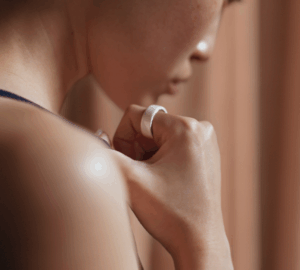In the face of the global pandemic, lifestyles around the world have been disrupted. Amidst this uncertainty, Oura’s goal is to share insights on how these disruptions are impacting our bodies in the hopes that we can emerge stronger and more informed about our health.
In a dataset of 45 million nights measured by the Oura Ring, analysis revealed that the pandemic led to a significant drop in average night-time resting heart rates when compared to 2019.
So, why is this significant? A lower resting heart rate is generally a sign of better health, performance, and recovery. This finding raises important questions about the effects of our ‘new normal’ and makes us think — what if social distancing is good for our health?
—
After pulling together past research and insights from 2020, we’ve compiled patterns that may help us better understand the pandemic’s impact on our bodies. These patterns are not intended to be end results but rather conversation starters for our future health and lifestyle decisions.
What Patterns Have We Seen In The Past?
In a recent conference paper, Oura data from 2016-2019 showed two notable patterns:
Resting Heart Rates Go Up On The Weekends
Your heart doesn’t know the difference between a Tuesday and a Saturday, but it does reflect the impact of our lively weekends. The pattern below shows the weekly variation in global resting heart rates (RHR) — lower during the weekdays and higher on the weekend as we engage in activities that increase our RHR (e.g., a night out on the town, an unusually late bedtime, or an increase in late night snacking).

Resting Heart Rates Shift With The Seasons
Oura’s unique longitudinal data also reveals a remarkable seasonal trend: RHR averages peak in the winter and reach their lowest averages at the end of the summer.

These wave-like fluctuations could be caused by biological, societal, or lifestyle factors. As the seasons change, we spend different amounts of time outside, engage in varying physical activities, and encounter notable events like summer holidays or flu season. One theory is that the RHR peak in December might reflect holiday stressors, while the decline in January reveals healthier lifestyles adopted at a large scale with New Year’s resolutions.
Either way, these patterns encourage us to look at the larger changes in our health over time (e.g., weeks, months) for insights into how our lifestyles impact our bodies.
How Has Social Distancing Shifted These Patterns?
In 2020, RHRs have decreased across the board — our weekends have dropped to weekday levels and our seasons look like summer.
When we looked at the global heart rate data from March to October in 2020, our first response was a double take and an immediate rerun of the numbers. Instead of going up or following their seasonal course, RHRs dropped by approximately 1 bpm starting in mid-March. In other words, RHRs hit summer-levels far earlier.

On top of that, although weekdays and weekends still had a few differences, our “elevated” weekend heart rates in 2020 had now dropped to the same level as 2019’s weekdays.

So, What’s Causing This Shift?
It could be that lockdown has given our bodies what they crave – consistency and alignment with their natural rhythms.
Like you, your body is opinionated and knows what it needs. Your body has a preference, or “chronotype,” for how your personal lifestyle aligns with the sun’s natural daily pattern. This preference is your body’s circadian rhythm, and it determines if you’re a “night owl” (more active in the evenings) or an “early bird” (more active in the mornings). You may not realize it, but, when you’re feeling your best, it’s probably on those days when your lifestyle has aligned with your body’s natural rhythm.
Under pre-pandemic ‘normal’ circumstances, many of us were out of alignment with our circadian rhythms, plagued by a phenomenon known as “social jet-lag” where you go to bed and wake up later on weekends than weekdays. This discrepancy causes us to feel fatigued or “jet-lagged.”
Why the shift? During weekdays, our sleeping habits and body’s preferences take a backseat, while our obligations or external schedules (e.g., school, work, social engagements) steer our lives. For many of us, this means we’re living according to our virtual calendars, rather than our chronotypes. Even when we have more flexibility on the weekends, we don’t always prioritize sleep.
What makes the pandemic different? During social distancing, some of us have been able to close the gap between our lifestyles and our body’s natural schedule, taking steps towards improving our sleep and health.
As our routines have shifted, some weekday schedules have become more flexible, school, home, office, errands are now all synonymous with home, and our weekend habits have shifted more towards staying in—helping us hit bedtimes more consistently. Instead of synchronizing our phones’ alarm clocks with a freeway commute or subway timeline, we may be given the flexibility to adjust our morning schedules to align with our bodies’ natural alarm clocks.
It’s important to recognize that society skews in favor of early birds. Early school and work start times put night owls at a biological disadvantage. When social distancing began in 2020, we saw a clear shift towards later bedtimes and later wake ups, suggesting that some of our night owls were shifting the balance.

So, What’s Next?
The data doesn’t lie, COVID and social distancing have changed our lives temporarily — for good and bad. These findings are intended to help us look at what positive lifestyle changes we can carry out of these tough times and into the future.
How does a packed schedule, a long commute, or our weekend entertainment impact the way our bodies operate?
If our routines continue to sync up with our bodies’ natural rhythms, and we continue to see patterns of improvement, we may be able to emerge from this having learned something positive: we have the power to improve our sleep and improve our health.
So, does this mean if our world begins to normalize we should cancel all our weekend plans and go to bed at 9pm each night? Of course not—but just knowing what works for your body can be the difference between a tired life and a fulfilled one.
How Oura Can Help
As we continue to look for patterns, it’s important to remember that even though we see these global trends, RHR is also highly personal, enabling individuals to look at their own long-term data and see how behavioral, societal, and seasonal factors impact their personal baselines.
Oura is specifically designed to enable this kind of discovery by:
- Allowing users to spot patterns in their Trends over time.
- Delivering high-quality data by leveraging a high sampling rate (250 Hz).
- Providing personalized insights from your nighttime data to make sure that you’re seeing your true body status rather than a reading influenced by daily confounding variables like movement, environmental conditions, and lifestyle habits (food, socializing, etc.).
- Recommending optimal bedtime windows based on what works best for your body, not population averages.
Your Oura Ring can be your number one resource on your health journey, helping make the idea of better sleep and better health a reality. If you go into a post-covid world equipped with the insights and self-knowledge you gained during the infamous year of 2020, you’ll know what your body needs to stay happy, healthy, and ready to take on what the world throws at you.










